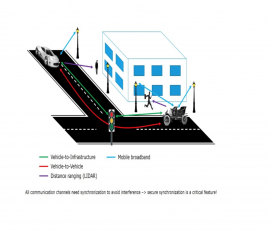
Resilient, Trustworthy, Ubiquitous Time Transfer
DESCRIPTION
Secure and reliable time transfer is a key enabler for the next generation of services worldwide. A number of different applications such as 5G mobile broadband, mobile multimedia broadcast, power grids, terrestrial positioning services, financial operations, IoT, big data and cloud processing will require accurate, secure and reliable time information to be able to work consistently and efficiently. The time information will need to be transferred not only securely, but also in a seamless and ubiquitous manner.
The most accurate and ubiquitous time transfer is currently realised through GNSS. Given high-quality frequency reference, a GNSS-based time source can keep time error with less than 30 ns error to UTC. There are a number of techniques to realise GNSS-based time transfer, including but not limited to: direct computation of Position, Velocity and Time; fixed mode (static) receiver solving for time only (not position); common GNSS satellite time only transfer; etc.
However, a common weakness of all GNSS-based time transfer techniques is that these methods are sensitive to spoofing (limited security), jamming and signal blockage (deep indoors).
On the other hand, traditional telecom-based time transfer methods that use two-way time transfer protocols (e.g. NTP or IEEE 1588v2 PTP) over terrestrial wire or wireless media are far more resilient to jamming and signal blockage. These media (and protocols) are far more secure (due to multiple layers of security), yet are limited in terms of accuracy due to inherent latency and asymmetry in the packet-based networks.
The main objective of the proposed activity is to put forward innovative and complementary methods of time transfer, focusing on the use of non-GNSS technologies. In order to enable an overall seamless provision of secure, ubiquitous and reliable time information, alternative solutions will be conceived to complement the current GNSS time transfer techniques with the emerging fixed and mobile services (e.g. autonomous vehicles, terrestrial positioning, 5G mobile broadband, 5G eMTC, and 5G V2X) and with space-based PNT services (e.g. Satelles).
The tasks to be performed will include:
- Review of requirements for different use cases, with the main focus on new emerging fixed and mobile services being studied by relevant working groups (e.g. ITU, 3GPP);
- Identification of enabling technologies including architecture, algorithms and protocols;
- Design, development and demonstration of the technology concepts;
The expected outputs are:
- Report on the requirements and use cases for new concepts being studied by relevant working groups (e.g. ITU, 3GPP);
- Report on the analysis of different enabling technologies, architectures, algorithms and protocols relevant to secure, reliable and ubiquitous time transfer;
- A test platform, to consolidate assumptions made on performance methodologies, models and techniques;
- Recommendations for follow-up activities, with the focus on standardisation of the proposed solutions.
esa-STAR link: http://emits.sso.esa.int/emits/owa/emits.main
